Make My School and All Others Police-Free
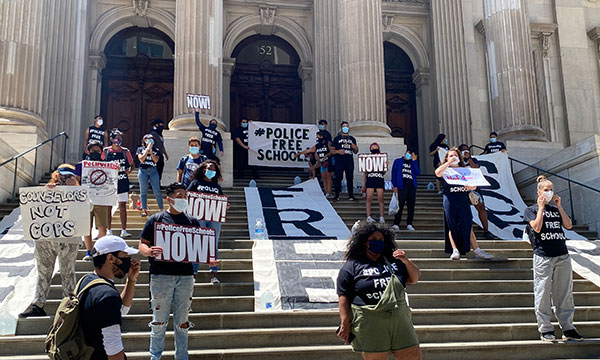
Students rally for police-free schools (photo: Urban Youth Collaborative)
Every morning, I walk through a metal detector to start my day. I’m one of thousands of students who attend heavily policed schools, where there are more school safety agents than nurses, guidance counselors, and therapists combined. Students of color like me deserve to feel safe and supported, not policed, in our classrooms — but a new proposal to simply transfer school safety agents from the NYPD to the Department of Education is no solution at all. For us students, the answer is clear: we need completely police-free schools.
Right now, even in a terrifying economic crisis, New York City spends more than $450,000,000 a year on over 5,100 school safety agents and policing equipment. In contrast, the average school in New York employs just one guidance counselor for every 357 students, and many of our schools are deeply underfunded in every other way. This divide — funding the police and underfunding everything else — is especially true in majority Black and brown schools like mine. But just one neighborhood away, my friend goes to a majority-white school without a single metal detector. The message we hear from the city is loud and clear: policing students of color is more important than educating us.
The ironic truth is that instead of creating a safe learning environment, the constant presence of cops makes us feel like criminals — and actually escalates conflicts between students and between students and adults. I’ve seen too many incidents that could have been resolved with counseling, but instead became violent because students panicked when the cops came in with handcuffs and batons. The data shows that policing does not reduce bullying or fighting, and instead criminalizes behavior that would just merit a visit to the principal's office in a better-off school. My worst experiences with cops in school are much less traumatic than those of many of my friends, but even day-to-day interactions — like getting pulled aside and examined, hands on the wall, when I forget my phone in my pocket while walking through a metal detector — are dehumanizing.
I’m glad to see that the public — and even the City Council — is beginning to see how dangerous this reality is. But let me be clear: we cannot settle for the sham proposal of transferring school safety agents from the NYPD to the DOE. A cop is still a cop — no matter who they’re getting their salary from.
Instead, New York City needs to invest in learning environments that will prevent the roots of violence. That means significantly increasing the ratio of guidance counselors to students. It means making sure that we have trained psychologists available to talk to, from K through 12. And it means investing in restorative justice trainers to mitigate conflict, because we deserve to learn from our mistakes instead of being suspended or arrested for them.
When I imagine a school that feels safe, I imagine walking into school and going straight to class — no metal detector in sight, no cop cars stationed outside, no school safety agents standing on the edge of the cafeteria, waiting to pounce. I know it's possible, because thousands of students in wealthier and whiter neighborhoods live that reality every day. Mayor Bill de Blasio and Speaker Corey Johnson — we demand that you give us the police-free schools that we deserve.
***
Akeria Adams is 16 year olds, attends Academy of Medical Technology in Queens, and is part of The Urban Youth Collaborative.
***
Have an op-ed idea or submission for Gotham Gazette? Email This email address is being protected from spambots. You need JavaScript enabled to view it.
New York City Can Rebuild Through This Budget Crisis – Here’s How
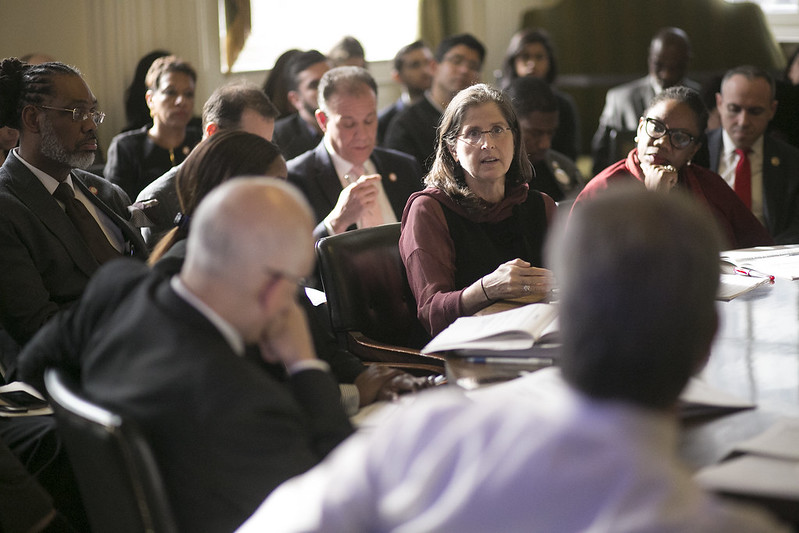
City Council Member Helen Rosenthal, the author (photo: William Alatriste/City Council)
By the end of the month, just a few days from now, New York City will have to pass a balanced budget. With additional drops in revenue, looming state cuts to education and health-care funding, and the growing unlikelihood of federal support for states and localities, piecing together a budget that does not cut critical programs and services will be almost impossible.
What does this mean for our future? How can we keep residents from giving up on New York City? How can we bring our local economy back?
As I’ve noted many times, there is no one silver bullet. To address its $10+ billion revenue shortfall, the city must assemble a package of solutions including productivity savings, cuts to services, new revenue opportunities, use of reserves, and borrowing. We need to be strategic and smart about how we close the gaps, while not further impacting our neighbors who have been most affected by the crisis.
The City Council has already identified roughly $3 billion in cuts and savings. This includes eliminating NYPD training academy classes and other cuts to the police department’s now $6 billion budget, trimming the Department of Education’s bloated central office, along with program and contract cost re-estimates across all city agencies. The city also has roughly $4 billion in reserves that can be used in the current crisis.
One thing is painfully clear -- additional cuts beyond those identified above will do more harm than good. Large-scale cuts would force thousands of city employees and other essential workers paid through city contracts to lose their jobs and health-care benefits. Many of these are union jobs. The people we need to keep our city functioning would be forced onto unemployment, impacting every aspect of society, from local businesses to our tax base.
An all-out austerity budget is also untenable because we are in the midst of a massive public health crisis. To date, the city has spent over $3 billion to keep New Yorkers safe -- from ventilators and masks to feeding over 1 million people every day to remote learning services for our children. And as we look toward opening schools in September, we must spend more money to keep our schools free of the coronavirus. One positive has been that some of these outlays have been subsidized through federal relief money targeted to covid-related expenses.
But given the budget hole and the damage more agency cuts would do, we must talk about bringing in more revenue. I continue to fight for creative solutions, such as the reinstatement of the Securities Transfer Tax, which could generate billions for New York City and State.
Borrowing - likely $2 billion this year - also has to be part of the conversation. The concept is a third rail for some legislators because it harkens back to a time when the city borrowed money under very different circumstances. It’s important to note that the fiscal crisis of the 1970s was caused by several factors unique to that period -- decades of population loss; hemorrhaging of local employers (especially industrial businesses) that helped impoverish the population and intensify the need for social spending; and poor management of the city’s finances.
But here is where times have changed. Prior to this pandemic, the rating agencies were confident in New York City’s ability to maintain a balanced budget. In February 2020, the city was awarded an Aa1 rating by Moody’s -- the highest in recent history. By mid-March, however, the coronavirus pandemic was crushing local economies everywhere. Without jobs, people can’t pay rent or taxes. Without revenue, the city can’t supply basic services, and meet the growing demand for food, health care, and social services.
Borrowing comes with real costs of course. The circumstances and depth of the crisis in the 1970s forced the city to relinquish a certain amount of control over its budget in exchange for financial relief. Today’s crisis requires different guardrails and strong oversight, but there is no need for the Financial Control Board to be re-activated wholesale with a state takeover of the city’s budget.
And there are other risks. Every $1 billion borrowed will cost New York City $25 million annually, assuming we use the full loan term to pay back what is owed. The city budget will take on this debt. We have to weigh these costs against what is needed to get us back on our feet.
Finally, as counter-intuitive as it sounds, additional, targeted city spending makes sense at this moment. A recent analysis by the City Comptroller found that over 900,000 fewer New Yorkers were working in May than in February. Communities of color and young people under age 24 have been particularly hard hit.
Such job losses weaken our economy further. We should continue to invest in our residents and our recovery through robust job training programs (including the Summer Youth Employment Program), and limiting cuts to social service programs. Beyond this, an additional $2-3 billion of borrowing could be split between the purchase of homes heading to foreclosure (before predatory equity buyers swoop in), plus some targeted infrastructure and housing construction. These investments will save taxpayer dollars in the long-term.
Even in a devastating crisis we have choices. Let’s not be afraid to plan for a more vibrant, caring, sustainable city while we adjust to a new fiscal landscape.
***
City Council Member Helen Rosenthal represents parts of Manhattan. On Twitter @HelenRosenthal.
***
Have an op-ed idea or submission for Gotham Gazette? Email This email address is being protected from spambots. You need JavaScript enabled to view it.
With Green Participatory Budgeting, Racial Justice and Climate Justice Go Hand in Hand
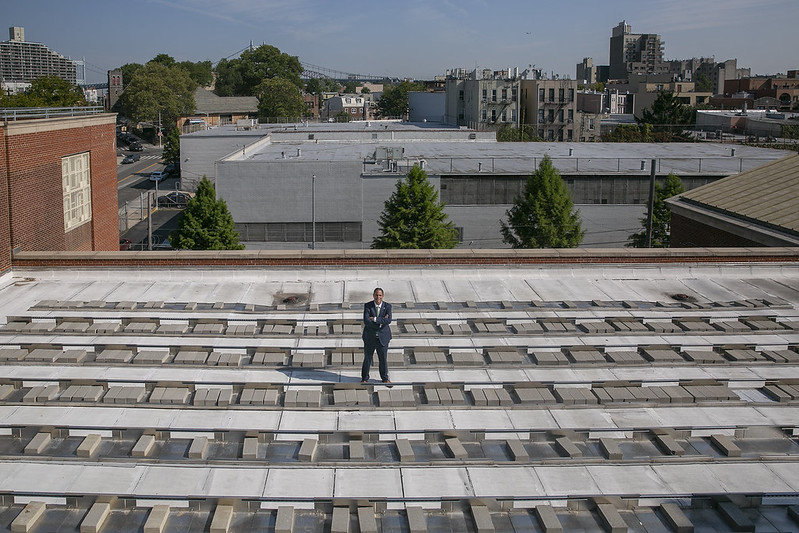
Solar panels in Queens (photo: William Alatriste/City Council)
The Black Lives Matter movement that has swept the country shows that New Yorkers demand not only equal treatment by law enforcement and an end to police brutality, but also greater government accountability and responsiveness to the needs of Black residents and other New Yorkers of color. Even before the protests began last month, the disproportionate impact of COVID-19 on Black and brown New Yorkers made clear that the pre-coronavirus world was unsustainable. Structural racism has magnified the crisis brought by the virus, especially in New York City. As we look to a post-covid future, we have to imagine a more equal society.
The pandemic and protests also highlight the urgency of fighting climate change — even as we stay focused on containing the epidemic, rebooting the economy, and responding to protesters’ demands. The United States has largely been unprepared for the pandemic, despite knowing for years that such a crisis could occur. Similarly, officials have known about the potential threat posed by climate change for decades. And the devastation caused by the virus might pale in comparison to the climate crisis, with more frequent and intense heat waves, more powerful hurricanes and flooding, food insecurity, and water shortages.
Climate change will also exacerbate the inequality that COVID-19 and police brutality have exposed: New Yorkers who struggle to make ends meet may be unable to bear the financial burden of rebuilding or moving if their homes are threatened by severe flooding, and the health dangers of heat waves and pollution disproportionately threaten New Yorkers of color. The City is already working to mitigate these risks. As New York City Chief Climate Policy Advisor Daniel A. Zarrilli wrote in April, “we can choose to emerge stronger and more resilient from this crisis with a green recovery that prioritizes clean energy infrastructure, job creation, and environmental justice.”
Green participatory budgeting, with which New York City can both tackle climate change and create a more equal, democratic society, should be part of this green recovery.
Participatory budgeting was first implemented 30 years ago in Porto Alegre, Brazil; the process allows citizens to propose and vote on local investment projects using a portion of the city’s budget. New York City’s participatory budgeting program, now carried out in dozens of City Council districts, launched in 2011. Studies from the City University of New York have shown that participatory budgets succeed in giving marginalized residents more power over their communities and are “more inclusive and attractive than local elections in terms of race and class,” which can help to reduce inequality.
By launching “green” participatory budgets — allocating money specifically towards projects focused on reducing greenhouse gas emissions and making neighborhoods more resilient to the effects of climate change — New York City can channel citizens’ enthusiasm to fight climate change into productive action and, at the same time, enjoy the social and democratic benefits of participatory initiatives.
Lisbon, which won the 2020 European Green Capital Award, may have been the first city to implement a green participatory budget last year, when it allocated 5 million euros to the initiative. Brussels’ city climate plan also includes a green participatory budget.
In May, Gotham Gazette reported that the expanded, citywide participatory budgeting program envisioned by the new Civic Engagement Commission is unlikely to be funded in light of the city’s fiscal crisis. However, the scale of the protests over the past two weeks shows that the city must be creative and flexible in reallocating resources. Funding as much of the Civic Engagement Commission’s $500 million proposal as possible, and allocating a portion of that budget to a green participatory budget, would represent a strong investment in New York communities most affected by COVID-19 and racism — which are often the same communities most vulnerable to the effects of climate change.
Right now, as New York City focuses on the multifaceted challenge that confronts it, it’s hard to imagine rolling out a new initiative like a green participatory budget. But this crisis has proven that robust local democracy is vital to provide solutions for our most pressing problems — and that New York residents are yearning for a more inclusive, just city. As we reconstruct our society in a post-covid world and strive to affirm that Black lives matter, let’s do everything we can to tackle the existential threat of climate change, and empower citizens to take matters into their own hands.
***
Nikhil Kumar is a recent graduate of the Harvard Kennedy School. He has worked on participatory democracy and municipal climate policy in Strasbourg and Helsinki.
***
Have an op-ed idea or submission for Gotham Gazette? Email This email address is being protected from spambots. You need JavaScript enabled to view it.
With Distributed Absentee Ballots Vastly Outnumbering In-Person Vote, Impact of Mail-In Ballots Could Be Dramatic
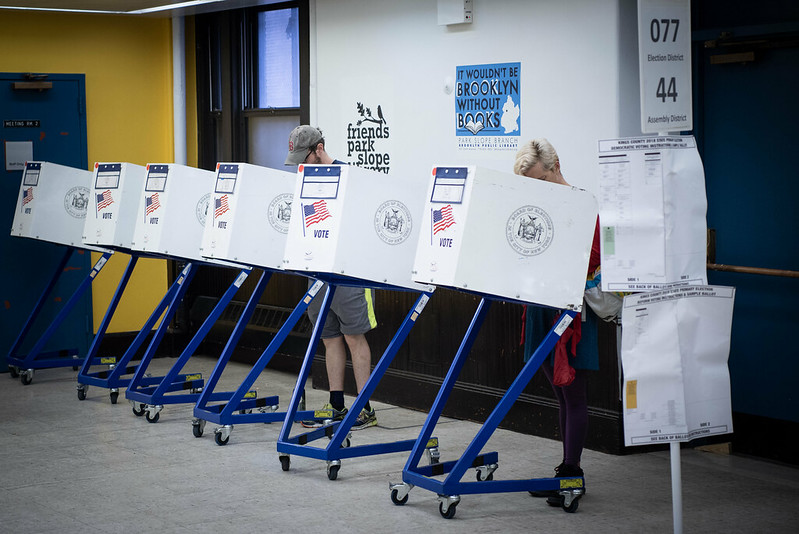
The absentee vote could trump the in-person vote (photo: Michael Appleton/Mayor's Office)
The New York City Board of Elections is reporting that over 765,000 absentee ballots were distributed to voters before primary day, June 23, vastly exceeding a tally of in-person votes in the Democratic presidential primary, which came to 471,000, with 96% of election precincts reporting.
The number of absentee ballots returned is not fully known yet, and none of the absentee ballots submitted by voters have been counted -- the results of those tallies will not be reported for about a week or more; the absentee count is considered daunting given how expanded the program was this year due to the coronavirus pandemic.
The Board of Elections must receive absentee ballots (postmarked no later than June 23) no later than June 30, and will publish further updates on how many absentee ballots have been returned on Monday, June 29 and Thursday July 2.
The update posted on Friday, June 26 shows the following borough by borough tally:
ABSENTEE BALLOTS - PRESIDENTIAL PRIMARY - NYC
| COUNTY | DISTRIBUTED | RETURNED (6/26) |
| Manhattan | 229,806 | 62,721 |
| Bronx | 99,026 | 17,589 |
| Brooklyn | 229,670 | 21,396 |
| Queens | 181,828 | 59,438 |
| Staten Island | 24,701 | 11,964 |
| TOTAL | 765,031 | 173,108 |
Using New York City Board of Elections data, the in-person New York City presidential primary vote was as follows:
IN-PERSON TALLY as of 6/23 (unofficial)
| Manhattan | 97,448 |
| Bronx | 85,344 |
| Brooklyn | 159,808 |
| Queens | 114,807 |
| Staten Island | 13,770 |
| TOTAL | 471,177 |
With such a large disparity between the number of absentee ballots sent out and the number of in-person votes (765,000 vs. 471,000) it seems quite possible that the number of absentee ballots actually returned will approach or even match the number of in-person votes. That means the results of the many primaries for Congress, State Senate, State Assembly, and Queens Borough President are very much incomplete, and do not reflect anywhere near the full vote.
It also means that in many close elections, the leaders on primary night could still lose, and different winners emerge, especially elections where the candidates are only separated by a few hundred votes. Only primary night leaders with very large margins could be considered safe winners.
Congressional Rep. Yvette Clarke from Brooklyn, for instance, got 62% of the in-person vote of 59,000, and was more than 26,000 votes ahead of Adem Bunkeddeko, who had about 18%. The Board of Elections reported 75,000 absentee ballots in the congressional district were sent out, meaning Bunkeddekko would have to win a highly lopsided margin of the absentees to overcome the in-person vote. That seems highly unlikely and Clarke could be considered a safe likely winner.
Congressional Rep. Carolyn Maloney, by contrast, although leading on primary night by 648 votes against her leading opponent, Suraj Patel, out of more than 39,000 in-person votes cast, still faces the risk of defeat. The Board of Elections sent out over 109,000 absentee ballots to voters in the 12th Congressional District (which spans three boroughs), more than 2.5 times the number of in-person votes.
How many of those absentee ballots will actually get returned? We don’t know. Maybe some of the ballots got lost in the mail, maybe some of the returns got lost in the mail, some of the voters ended up voting in person, and some voters didn’t do anything. But it seems reasonable to assume the number of absentee votes in NY-12 will exceed, perhaps by a large number, the in-person vote and we have no idea who the winner might be.
Congressional Rep. Eliot Engel seems too far behind to overcome the lead of his opponent, Jamaal Bowman, who has declared victory in NY-16. Engel is losing by 27 percentage points, about 27,000 to 15,000, out of 44,000 votes cast. The Boards of Election, including both the Bronx and Westchester, sent out 61,000 absentee ballots, but some will not be returned. The Board of Elections absentee return rate in the Bronx part of the 16th Congressional district was only 19% by Friday evening (6/26) and the Westchester elections board is not publishing absentee ballot returns. Nonetheless, Engel would have to achieve an overwhelming reversal of the in-person vote to win the election. Bowman seems the certain winner.
Several State Assembly primaries featuring incumbents versus challengers look too close to call. Assemblymember Aravella Simotas, from the 36th District in Astoria, Queens, is behind her challenger, Zohran Mamdani, by almost 600 votes out of nearly 8,000 cast. But over 16,000 absentee ballots were sent out in the 36th, so she could make up her current losing margin.
Michael DenDekker, in the 34th district, also in western Queens, is behind his opponent, Jessica Gonzalez-Rojas, 1,417-2,514, or 23%-40%, out of 6,200 in-person votes cast, with two other candidates getting nearly 1,800 combined votes. There were about 13,000 absentee ballots sent out. Can Assemblymember DenDekker make up a margin of 1,100 from the absentees? It is certainly still possible if daunting.
In Brooklyn two incumbent Assemblymembers are ahead but the elections are quite close. Assemblymember Walter Mosley, from Fort Greene-Clinton Hill, is ahead by 588 votes, 7,482-6,894, out of 14,414 in-person votes cast, over challenger Phara Souffrant Forrest. But almost 26,000 absentee ballots were sent out in this high-voting Brooklyn district, clearly opening the possibility that the challenger can catch up.
Assemblymember Felix Ortiz from Sunset Park leads his nearest challenger, Marcela Mitaynes, by 464 votes, 2,391-1,927, out of nearly 6,200 in-person votes cast. Two other challengers got 1,850 votes between them, and there were 8,841 absentee ballots sent out. The Friday evening report of absentee ballots returned in the district was only 820, less than 10%. Why this district and the other Brooklyn districts are showing return rates of less than 10% while the other boroughs return rates posted June 26 were significantly higher is not clear. But if the Brooklyn absentee ballot returns ultimately approach those of the other boroughs Ortiz’s opponent might still catch up.
Assemblymember Joe Lentol, a 47-year incumbent from Greenpoint, leads his opponent, Emily Gallagher, by more than 1,700 votes, 6,608-4,845, out of 11,500 in-person votes cast. Nearly 17,000 absentee ballots were sent out in the vote-rich 50th Assembly District. Gallagher seems unlikely to overcome that large a margin, but with such a significant number of absentees over the in-person vote, it is certainly not impossible.
Expansion of Mail Balloting May Help Produce an Immense City Democratic Primary Turnout Despite Pandemic
The two largest Democratic primary turnouts in recent history were the highly competitive and well-publicized 2016 Sanders-Clinton presidential primary, with 996,000 votes, and the 2018 gubernatorial primary between Andrew Cuomo and Cynthia Nixon, with 855,000 votes.
But this year traditional in-person campaigning largely vanished due to the pandemic. Candidates and their supporters were not knocking on doors or pumping out literature at subways, street fairs, supermarkets, and farmers’ markets to anywhere near the same degree. Instead, every Democratic voter got an absentee ballot application. The voter had to send in the application, get the ballot back, and then send in the ballot. The campaigns used direct mail, phone banking, texting,and social media.
The in-person tally is likely to reach about 500,000 votes despite the pandemic. 765,000 absentee ballots were mailed out by the New York City Board of Elections. If 500,000 of these ballots are returned, New York City Democratic voters will match the turnout in the last presidential primary despite this year’s Democratic presidential primary being effectively over because Vice President Biden has already clinched the nomination. If 50% of the absentee ballots are returned (382,500), the City will exceed the turnout of the 2018 gubernatorial primary.
Driving turnout this year are the many Democratic primaries. Eleven of the 13 congressional districts in the city have primaries, there are 26 Assembly district primaries, ten State Senate primaries, the Queens Borough President primary, and dozens of party office primaries. The local competitions helped compensate for the possible lack of interest in the presidential primary.
There’s a Results Lag But Big Changes Afoot with Constitutional Amendment on Absentee Ballot Voting
If a trend toward large numbers of mail ballots continues, we won’t know the results of elections on election nights if the races are close, but increasing participation seems like a good bet if we make no-excuse absentee voting permanent. A constitutional amendment is required in New York to institutionalize such a change.
The New York Constitution requires a reason for a voter to vote absentee, like illness, disability, or absence from the state on election day. Through executive order Governor Cuomo added COVID-19 (risk of serious illness or death) as a valid reason to vote by absentee this year, but we all hope COVID-19 will subside soon. The New York Legislature is in the process of putting the constitutional change on the ballot for November 2021. The Legislature voted in 2019 to do this and has to vote again in 2021 to get the question before the electorate that fall.
Absentee Balloting Differences Under Current System
There were major differences by borough in the percentage of persons who voted in person during early voting or on primary day versus the number of absentee ballots sent out by the Board of Elections in each borough. Every voter was supposed to at first receive an absentee ballot application, and had to send the application in before the Board sent out the ballot. Here’s a look at the percentage of in-person votes by borough compared to the number of absentee ballots distributed by the Board by borough:
IN-PERSON VOTES AS % OF ABSENTEE BALLOTS DISTRIBUTED
| IN-PERSON | ABSENTEE BALLOTS SENT | % | |
| Manhattan | 97,448 | 229,806 | 42.4 |
| Bronx | 85,344 | 99,026 | 86.2 |
| Brooklyn | 159,808 | 229,670 | 69.6 |
| Queens | 114,807 | 181,828 | 63.1 |
| Staten Island | 13,770 | 24,701 | 55.7 |
| TOTAL | 471,177 | 765,031 | 61.6 |
In more affluent Manhattan, the in-person vote was only 42% of the number of absentee ballots distributed to voters there. Two-and-a-half times as many voters sought an absentee ballot in Manhattan as went to the polls in person (230,000 versus 97,000). By contrast, in the Bronx, the city’s poorest borough, the number of persons who voted in person nearly equaled the number of persons who were sent absentee ballots, meaning the number of eligible persons who applied for them (85,000 versus 99,000, or 86%). The other boroughs had a mid-range compared to the richest and the poorest.
Why was this? This is an important question to ponder and study. Issues such as mail delivery, ballot application messaging, stresses of the public health and economic crises, and more need to be considered. Obviously mailing only the ballots themselves could have an impact on participation more broadly.
There were plenty of anecdotal reports that voters got their absentee ballots too late and ended up voting in person. I may be overestimating how many absentee ballots were returned. Like any election, there will be a round of significant problems uncovered. The Board of Elections will need greater accountability as we move toward more absentee ballots, like reporting requirements on a regular basis as to how many requests are coming in and when the ballots are being mailed. But there is likely to be a dramatic transformation beginning with the initial broad use of mail-in ballots in New York.
***
Jim Brennan was a member of the New York State Assembly for 32 years, where he chaired four committees. On Twitter @JimBrennanNY.
***
Have an op-ed idea or submission for Gotham Gazette? Email This email address is being protected from spambots. You need JavaScript enabled to view it.
We Must Stay True to Our Values and Avoid Devastation in a Painful City Budget Process
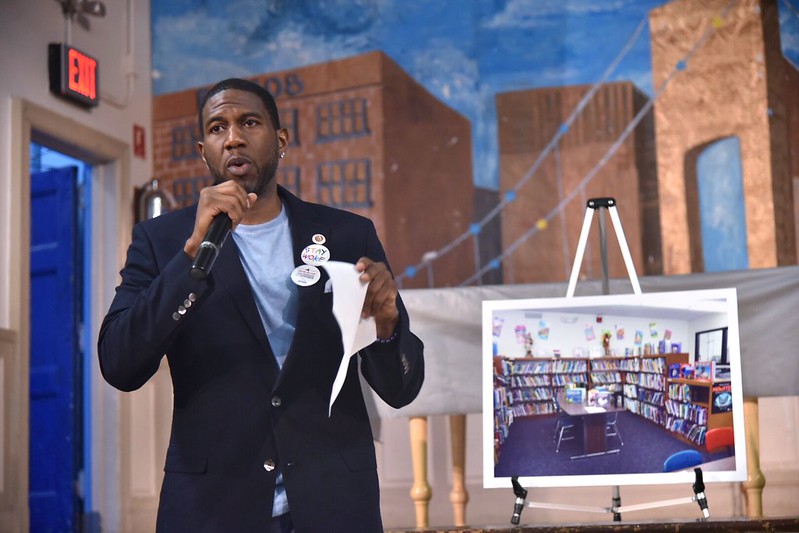
Public Advocate Jumaane Williams, the author (photo: John McCarten/City Council)
Crises are about our choices, and they reveal our priorities. I've always said that it's easy to be progressive in times of surplus, but that when funding is cut or curtailed, it is all the more important to stand by progressive values.
Addressing the COVID-19 pandemic has put extraordinary strain on the city's finances, and in accounting for this, human responsibility must be paramount. Facing $10 billion in lost tax revenue, sacrifices will be necessary but should not be short-sighted.
This past week, Mayor de Blasio threatened to lay off 22,000 city employees, many of whom would be from the very same communities hardest hit by COVID-19.
We have to meet financial need while preventing human cost.
This is a moment of extraordinary shifts in government and society, rooted in longstanding issues and inequities, exacerbated by the COVID-19 pandemic. That pandemic has taken the lives of tens of thousands and the jobs of hundreds of thousands of New Yorkers, and set in motion the worst economic crisis we’ve seen in a century. With the jobs New Yorkers have already lost, many of which will not return, with the homes they may lose as an end to the eviction moratorium approaches, it is time for drastic but responsible action.
The budget that the mayor is currently proposing would cause further damage for our city in ways we cannot afford by abandoning programs we need and values we hold. Each of the crises we are facing has also disproportionately devastated communities of more color, and the proposed cuts to many social services would be no exception.
The inclination in times of economic downturn is to cut. And of course some sacrifices, major sacrifices, painful sacrifices, will be necessary. But we cannot cut our way out of a crisis – we need to invest in our future. We need to invest in New Yorkers. Cutting programs that are critical to our growth and development – like youth jobs and services – is not a path on which we can grow, it will only take us backward.
There are cuts that can and must be made, but the best path forward for investing in our city is to employ long-term borrowing.
This is a fiscally-sound and clearly-necessary strategy to meet the current economic crisis without further irreparable damage to vital programs and the New Yorkers who rely on them.
Borrowing is not a radical idea. Unlike short-term borrowing, it is not an imprudent proposal. In past crises, we have taken on long-term debt and been able to move forward and build a strong recovery. I believe we must do so again, and fear if we do not, that recovery will not come.
Following the attacks of September 11, 2001, the city engaged in this kind of long-term borrowing. It was a necessary step, and we have shown in the time since our ability as a city to use that infusion to recover, grow, and pay down what is owed. Now, we have an even greater economic crisis before us, and it would be irresponsible not to explore how best to use this tool once more. It’s not a partisan issue, not a radical proposal – Mayor Bloomberg was granted such permission through Albany, where the power resides, and now Mayor de Blasio is right to ask for the same.
I understand that many have had a knee-jerk negative reaction to this concept when it was put forward by Mayor de Blasio – and I understand that in this moment our mayor is an imperfect messenger on many things. But this is the right message.
For many, I believe, the fears of long-term borrowing stem from the fiscal crisis in New York City in the 1970s – but they are taking only a partial lesson from that period, a time when austerity cuts to social services did not save the city’s economy but rather devastated the people who should be driving it. After 9/11, faced with a more acute crisis and immediate response, borrowing was the right thing to do, as we’ve shown in the years since.
Right now, the reality is that there are no perfect options and no entirely positive actions. But we have a choice in this moment to accept a difficult path or careen down a devastating one. The greatest impediment to recovery at this time would be even deeper layoffs, even larger unemployment. Avoiding slashing vital programs and the employees that make them possible is paramount.
Voices saying that taking on new debt now in order to avoid debilitating cuts would be making our children solve our problems are approaching this issue wrong – by cutting crucial services, we would create a worse future and cause more damage. Even a modest amount of long-term borrowing -- in the $4-$7 billion range -- now would be critical to securing the city’s economic standing – especially when supplemented by allowing fair taxation of New York City’s millionaires and billionaires, which is crucial in the long-term.
As the budget deadline looms, though, Democrats who control state government in Albany need to immediately grant the city the power to take borrowing action that meets the scope of this crisis. For all his statements of concern and his desire to block city government at every turn, Governor Andrew Cuomo knows this too – after intense pressure from advocates to take the most basic, obvious action, he was willing to accept infusions of borrowed funding on the state level. He cannot now oppose the city trying to do the same.
Austerity is bad policy, no matter who proposes it. It deepens the existing inequities that COVID-19 has already exposed and exacerbated. Make cuts where they are needed, like at the NYPD, but not where such cuts would have deep, lasting, devastating impact on our city’s youth and its future.
Borrowing will lead to a debt we can repay as we recover. Aggressive austerity will lead to damage we may never recover from.
***
Jumaane Williams is the New York City Public Advocate. On Twitter @JumaaneWilliams.
***
Have an op-ed idea or submission for Gotham Gazette? Email This email address is being protected from spambots. You need JavaScript enabled to view it.
With Mass Evictions and Real Estate Speculation Looming, City and State Leaders Must Give Communities Opportunity to Own Their Own Land
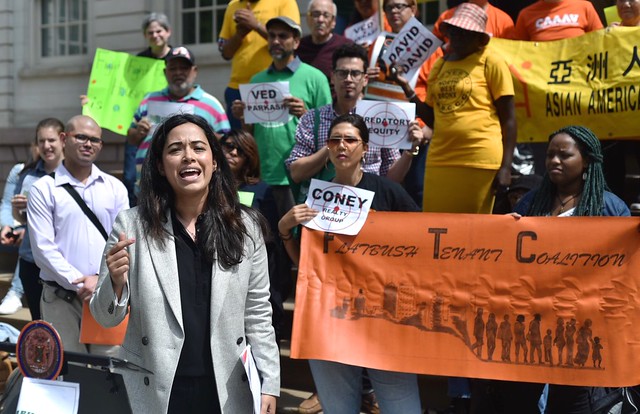
Council Member Rivera at a CLT rally (photo: John McCarten/City Council)
In the wake of the COVID-19 pandemic, New York faces two new fronts in its housing crisis -- a wave of heightened speculation likely to destabilize communities and an onslaught of expected evictions as housing courts reopen.
As Mayor de Blasio and the City Council approach the June 30 deadline for voting on the fiscal year 2021 budget, communities of color hardest hit by the COVID-19 pandemic are not seeing anywhere near the requisite level of support to combat these crises.
Although the city faces real fiscal challenges, we must reject austerity measures that would disproportionately harm Black and brown communities already reeling from coronavirus, job losses, and so many other glaring inequities. Instead, we must ensure a budget that prioritizes neighborhood equity and lays groundwork for a just recovery -- starting with support for community land trusts (CLTs).
Last year, the city provided groundbreaking funding to help launch a dozen CLTs in neighborhoods across the city -- a crucial step toward giving communities control over land and housing. The city should renew funding for the citywide CLT initiative to address the deepening housing crisis and continue to advance community-led development.
Rooted in civil rights struggles in the South, CLTs combine land ownership and management with community organizing. Community residents work together to collectively decide how to acquire and develop land, meet community needs and preserve affordability for future generations.
One of the most successful CLTs in the country is right here on the Lower East Side. For almost 30 years, the Cooper Square CLT has stewarded hundreds of units of permanently-affordable housing and dozens of commercial storefronts with below-market rents. The CLT and its affiliated Mutual Housing Association reach deep affordability through economies of scale, ensuring that rents remain affordable at levels that meet neighborhood needs.
Inspired by the success of Cooper Square and other CLTs across the country, a new generation of land trusts is emerging across the city -- from Tremont and Melrose to Jackson Heights, East New York, and beyond -- to take land and housing out of the speculative market, for good. Continued support is critical as CLTs move toward acquiring property for deeply and permanently affordable housing, retail and arts spaces, and other community needs.
But we also need to give CLTs, along with mutual and resident-controlled housing, the tools they need to succeed.
That’s why we’re also fighting for passage of two pieces of legislation -- the Community Opportunity to Purchase Act (COPA) in the City Council and the Tenant Opportunity to Purchase Act (TOPA) in the State Legislature.
COPA would immediately give CLTs, non-profit affordable housing developers, and other organizations a right of first refusal whenever landlords decide to sell apartment buildings or property, ensuring they have time to secure and develop the funds necessary to make competitive offers on available property. TOPA would give the same right of first refusal to individual tenant organizations to purchase their own properties.
The need -- and opportunity -- for CLTs and community ownership initiatives has never been greater. As land and housing prices tumble in the wake of COVID-19, CLTs will be critical to guard against ramped-up real estate speculation, which wreaked havoc in Black and brown communities after the 2008 financial crash. Foreclosures rarely occur on CLT-owned land, as just one example of their stabilizing impact. With land trusts forming across the five boroughs, the time to redouble our commitment to this model is now.
In his State of the City speech earlier this year, Mayor de Blasio announced his administration’s support for CLTs, including a commitment to add 3,000 units of housing on CLT land over two years. The mayor and the Council must deliver on this pledge.
The coronavirus has brutally exposed inequities in our city, and the insufficiency of current approaches to housing, health care, and so much more. A just recovery will require centering solutions developed by community residents to achieve true community safety and self-determination. New York City should make sure that CLTs and community-led development are part of the equation.
***
City Council Member Carlina Rivera represents parts of Manhattan. Deyanira Del Río is Co-Director of New Economy Project. On Twitter @CarlinaRivera & @deydelrio.
***
Have an op-ed idea or submission for Gotham Gazette? Email This email address is being protected from spambots. You need JavaScript enabled to view it.
City Threatens to Exacerbate Affordable Housing Crisis for New York Seniors
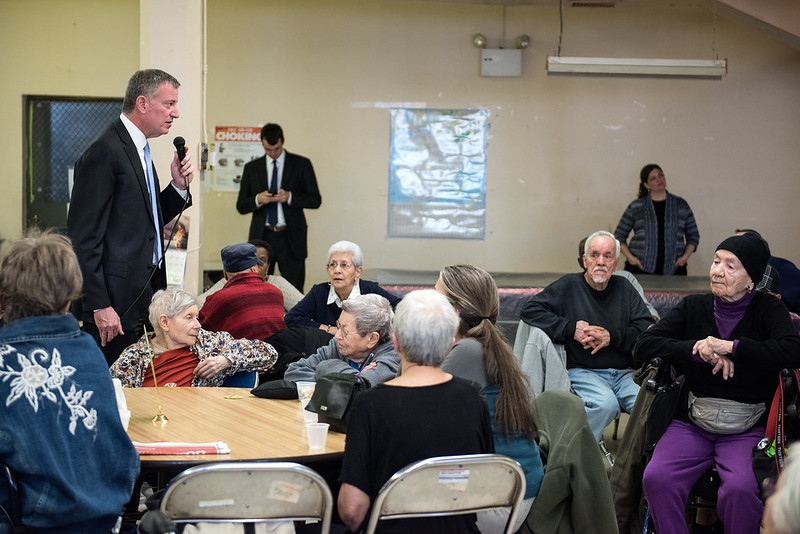
Mayor de Blasio talks with seniors (photo: Demetrius Freeman/Mayor's Office)
For far too long, older adults in New York City have been struggling to find a safe and affordable place to call home. The pandemic has exacerbated these challenges and exacerbated an affordable housing emergency that’s especially dangerous for populations including New York’s low-income seniors. As we look to recover, we need to prioritize the sustained production of affordable housing, particularly as a way to stabilize and support our older residents now and in the future.
Older New Yorkers were struggling to make rent even before the pandemic hit. More than one-quarter (27 percent) of New York’s renters are 60 or older, the highest share in the country. Nearly one in seven seniors in the city live in poverty, according to a report from the Center for an Urban Future, and more than 200,000 seniors are on a waiting list for the Department of Housing and Urban Development’s (HUD) Section 202 program, according to LiveOn NY.
In fact, demographic data suggests that the senior population in the five boroughs will increase 50 percent by 2040. The need for quality, safe, and affordable housing for seniors will become more vital as our city continues to age.
Unfortunately, the latest capital budget proposed by the de Blasio administration misses the mark in this regard. The budget would cut funding to the Department of Housing Preservation and Development (HPD) by 40 percent, resulting in a loss of up to 21,000 of affordable units over the next two years, according to a recent study from the New York Housing Conference.
There is a shadow of doubt over the entire pipeline and it is older New Yorkers that will be left behind. It is vital that the city fund, develop, and finish projects designed specifically to address seniors. For example, a project in the proposal stage in Astoria that would provide deeply affordable homes to New Yorkers over the age of 62 but may now be significantly delayed or even halted entirely.
This is just one example of many projects designed to address this growing need and the loss is incalculable for New Yorkers that need these homes now. New York City’s aging population is depending on our elected officials to make smart policy decisions that will protect them, especially during these unprecedented times. City Hall must reverse the budget cut and commit to provide critical funding for lifelong New Yorkers in their most vulnerable years.
In fact, prioritizing affordable housing development will help pave the way toward economic recovery. A NYSAFAH study found that a 100-unit affordable housing development in New York typically generates nearly 200 construction jobs and 20 permanent jobs. Additionally, the development would result in an average of nearly $30 million in economic spending during construction and over $3.5 million in sustained local economic activity.
In other words, investment in affordable housing not only addresses critical needs, it generates critical economic activity. It’s win-win every time.
Fully funding HPD’s capital budget is the sort of low-risk policy proposal that will pay dividends in both the short- and long-term. It is exactly what we need right now – and it will remind elderly New Yorkers that their elected officials have their best interests at heart.
***
Jolie Milstein is the president and CEO of the New York State Association for Affordable Housing. Allison Nickerson is the Executive Director of LiveOn NY. Karen Haycox is CEO of Habitat for Humanity NYC and President of the Habitat NYC Community Loan Fund. On Twitter @NYSAFAH & @liveonny & @HabitatNYC.
***
Have an op-ed idea or submission for Gotham Gazette? Email This email address is being protected from spambots. You need JavaScript enabled to view it.
Defund the DOC, Invest in Supportive Housing
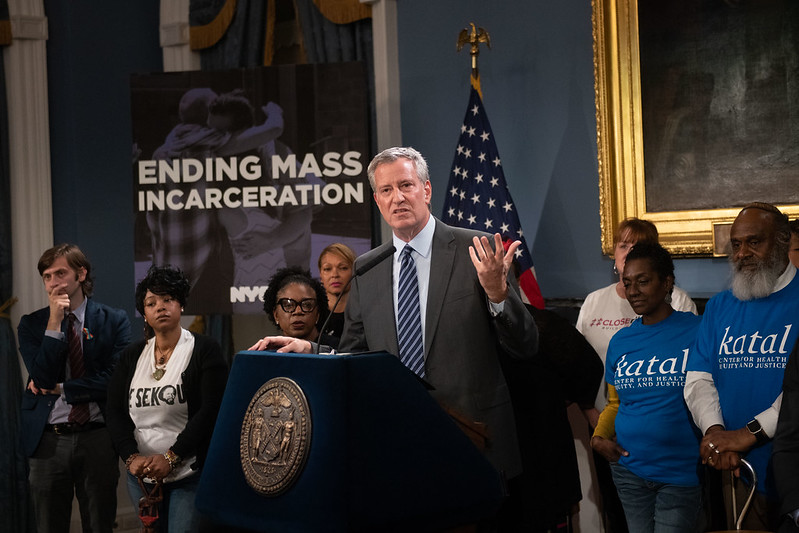
Mayor de Blasio discussing jails (photo: Michael Appleton/Mayor's Office)
Michael Tyson, Raymond Rivera, Layleen Polanco, Wayne Henderson, Kalief Browder, Jerome Murdough, Bradley Ballard, Carlos Mercado, Ronald Spear. Just some of the Black and brown people who have died in recent years from neglect or abuse at Rikers Island. As our city and country demand justice for racial inequities in policing and beyond, the budget for New York City’s brutally violent, racially unjust, fiscally unjustifiable Department of Correction must be cut. The savings should be redirected to programs proven to keep people out of jail and advance safety, through a combination of housing and wrap-around services.
Imagine that you are locked up, punished without having been convicted, in a sweltering cage in one of the nine jails on Rikers Island. Imagine that your economic security has been destroyed and your family relationships ripped apart based on an accusation. This disproportionately happens to Black and Latino people, who are not afforded the same opportunities of innocence until proven guilty.
We make up 88 percent of the people incarcerated in New York City jails. We experience the extreme violence of Rikers, which is at an all-time high. We are isolated at Rikers from families, attorneys, and service providers. We fail to receive mental health care and other needed services.
Even if you believe in incarceration as punishment and incapacitation, Rikers is much more than that: it is unequitable, unconstitutional, and unfathomably expensive.
This year, New York City is spending $2.5 billion to jail people, amounting to more than $400,000 per person per year.
With the city’s jail population at a low unseen since World War II, we can save hundreds of millions from the DOC budget by continuing a hiring freeze, cutting jail riot squads that a federal court’s monitor found exacerbate violence, greatly reducing overtime, and continuing to close sparsely-populated jails. Then we can multiply those savings by broadening the scope of and resolutely funding far cheaper alternatives to Rikers that we know work better.
A key element: provide housing when needed. Since 2017, the Women’s Community Justice Project has provided housing and services to homeless women jailed at Rikers pending trial for a wide range of alleged crimes. Of over 200 women served—the majority of whom are mothers and caregivers, often battling mental illness and substance use—98 percent made all court appearances and only two were charged with new crimes. The average cost: $30,000 per person per year, 1/13 the cost of Rikers.
In March 2020, to alleviate the close confinement that was causing coronavirus to spread in New York City jails at nine times the rate of the rest of the city, the DOC released 312 people who had been sentenced to less than a year in jail. Many had long histories of homelessness, serious mental illness, and substance use. Some were effectively doing life sentences one misdemeanor conviction at a time, demonstrating that repeatedly jailing them had failed them – and us.
For a fraction of the cost of Rikers, the city traded the brutality and degradation of Rikers for emergency housing and wrap-around services offered by Exodus Transitional Community and other non-profits. People have been connected to social services, treatment, jobs, and long-term housing at rates previously unseen. Only one program participant has been re-arrested for a serious violent offense. These results speak for themselves.
The remaining savings should be a down-payment on community-led investments in Black and brown neighborhoods ravaged by COVID-19 and long harmed by Rikers.
We also urge City Hall to press forward with the much smaller borough jails needed to end Rikers. Every month of delay condemns thousands of Black and brown people to continued abuse and mistreatment at Rikers. Construction will also generate thousands of critically-needed, good-paying jobs. To keep on schedule, we need to spend only enough this year to allow the planning process to proceed and begin to demolish the decrepit jail in downtown Brooklyn.
We can work together to end the glaring racial inequities and inequalities in our city’s criminal justice system, embodied in the Department of Correction and Rikers Island. These institutions have inexcusably harmed Black and brown people for decades. By cutting DOC’s budget and investing in housing and services, we can advance racial justice, economic sense, and safer streets. This is a no-brainer.
***
Dr. Alethea Taylor is the former Executive Director of Greenhope Services for Women, Inc. Julio Medina is founder, executive director, and CEO of Exodus Transitional Community.
***
Have an op-ed idea or submission for Gotham Gazette? Email This email address is being protected from spambots. You need JavaScript enabled to view it.
How We Must Reinvent New York City Education After Coronavirus
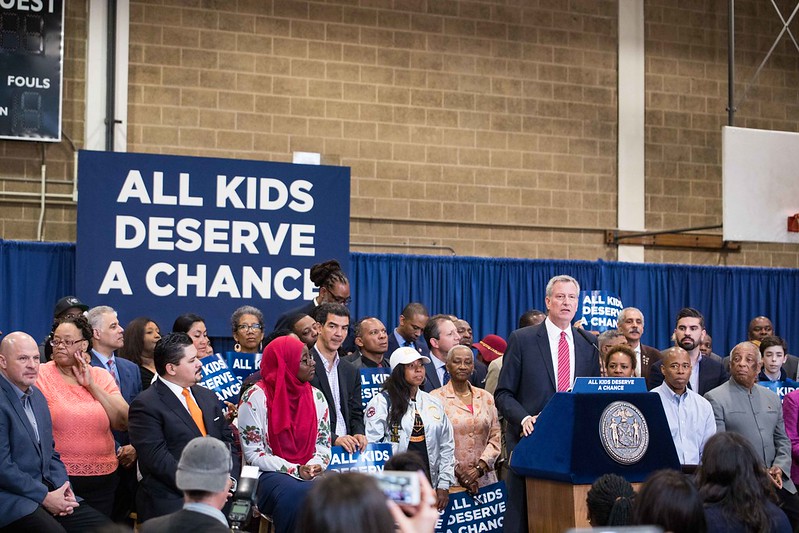
(photo: Benjamin Kanter/Mayoral Photo Office)
It’s 8:30 a.m. on a Tuesday. My youngest, now 13, needs help setting up for the Zoom meeting I wrangled with his math teacher so they can address how his dyscalculia is making fractions difficult. My middle child has just roused, a mark of my hard-earned success in resetting her circadian rhythm disrupted by these strange times. My eldest wants to discuss whether she should take “no-grade” on one of her courses during her second semester in college—the transition to remote learning at home has been too rocky for her to maintain focus on each course.
My home is a microcosm for how COVID-19 has turned education upside down. This disruption hits even harder for single-parent homes, families with students who have learning disorders or disabilities, and multi-generational families like mine. Like tens of thousands of other parents, I’m focused on how we can make things better for us and our kids.
I know these things from a professional perspective, too. For over a decade I have fought for equitable school funding, increased capacity for quality child care, for better access to dyslexia diagnostic services and support especially in low-income communities, and against the emphasis on testing in public education.
We need a systematic reimagining of public education, and what better time than now. But that phrase has been bandied about a lot recently by some people with pretty different ideas than mine. I’m never going to go along with billionaires “redesigning” public schools—that experiment over the past 20 years did more harm than good. When I say reimagine, here’s what I mean.
We need to focus our school communities on healing from the traumas of COVID-19 and racism. Schools in working-class neighborhoods and neighborhoods of color were already at a disadvantage before the crisis in terms of funding and access to resources. These neighborhoods also have been some of the hardest hit by the virus.
This is a pivotal moment in our history. If we believe Black lives matter, how do we turn that philosophy into reality for today’s students? Now is the time to rethink our approach to school culture—get rid of the metal detectors, train school communities in restorative justice, and institute a comprehensive social-emotional learning curriculum developed with high-trauma populations in mind.
Much of this work starts before children even enter a classroom. Our interventions must start with universal child care—including subsidies for families, increased capacity for infant and toddler care, and pay parity for child-care providers and early childhood teachers. The cost of child care for more than one child can rival the cost of paying rent. This is especially crippling for single mothers. When it comes to 3K, pre-K, and kindergarten, we should listen to the experts who highlight the importance of play-centered education.
Throughout our children’s education, we also must commit to curricular best practices that move us away from high-stakes testing. The state tests were canceled for COVID-19 this year, as were the Regents Exams, and no student will be the worse for it.
We need to adopt holistic evaluation methods like portfolio reviews that meet the needs and measure the growth of all students where they are. These changes are especially important for multilingual learners and students with learning disorders or disabilities, whom high-stakes testing harms the most.
Such curricular best practices include culturally-responsive education that builds on students’ experiences in the world. Likewise, the power of movement must be recognized in providing physical education as already mandated by the state but too often not provided. Expression through the arts cannot be just a luxury afforded to the wealthiest schools, not when we know how transformative and healing these practices can be for our kids.
Spending less time on testing will make it possible to offer courses our students will need for life outside high school like civics and financial literacy. It will also help us shift the focus to emphasize the interpersonal skills that will prepare our students to thrive in careers of social work, health care, education, and other low-carbon work we will need more of as we face the defining challenge we are passing on to the next generations, the climate crisis.
We will also need to reduce class sizes. The kind of attention our students need coming out of this crisis necessitates a lower student-to-teacher ratio. The current average class size of 24 for K–3 classrooms and almost 27 for grades 4–8 are far too high, and unconscionable in the wake of COVID-19. For our students to re-engage with learning when they go back to school buildings, we need to have smaller class sizes. Teachers are the primary support for our students, and they must be given the time to focus on the individual growth areas of each student.
As those of us working from home have seen in our own remote work, technology can indeed be a powerful tool for connection. But the flip side is privacy, especially when it comes to our children. As privatizing forces move in post-coronavirus to “reimagine” education through technological solutions, we need to draw hard and fast lines to protect the privacy of each member of our school communities. Data privacy can’t be an afterthought; it has to be baked in at the outset. It’s another reason to keep billionaires and giant tech companies out of our schools.
All of these policy ideas already exist in well-researched, ready-to-execute forms. What we have lacked is the political will to make them happen at scale.
Now is our chance. In this upcoming New York City budget, due in just a few days, we have to reject austerity. We must surgically defund the NYPD budget not just to preserve but to grow our spending on these crucial policy initiatives like smaller class sizes and retooling school culture. At the same time, we need to consolidate administrative sprawl within the Department of Education so our response to the traumas of COVID-19 can be swift and more effective for our students.
The City Council has an opportunity to step up to the plate for our children, and with 41 of them term-limited out at the end of 2021, it’s their chance to leave an impressive legacy of support for our students when they need it the most.
***
Johanna Garcia is a chief of staff in the New York State Senate, a former president of Community Education Council District 6, and a candidate for City Council in Manhattan’s 10th District. On Twitter @JohannaG_NYC.
***
Have an op-ed idea or submission for Gotham Gazette? Email This email address is being protected from spambots. You need JavaScript enabled to view it.
Defund the NYPD and Save Black and Brown Lives by Reforming Mental Health Crisis Response
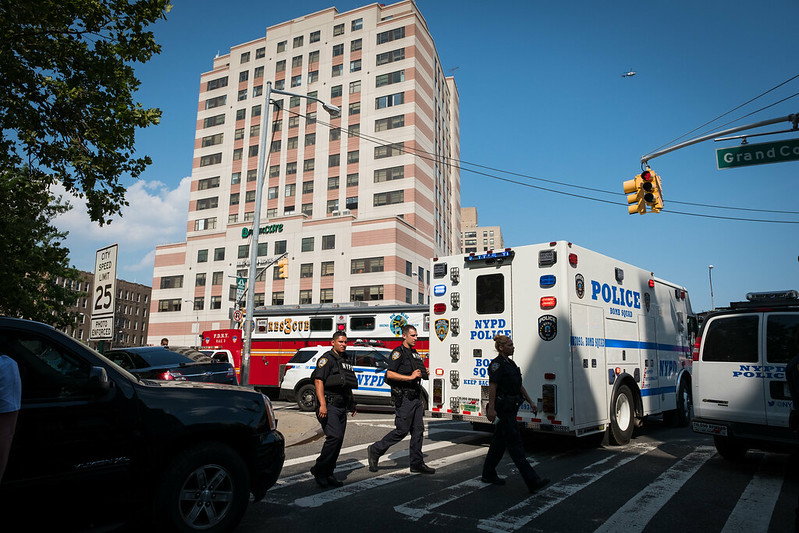
Questioning one role of the NYPD (photo: Edwin J. Torres/Mayor's Office)
The protests that have erupted across American cities in response to the murder of George Floyd, together with the larger movement for Black lives, have amplified advocates’ calls to defund the police and reallocate resources toward services that would better meet the needs of Black Americans and over-policed communities nationwide.
New York City’s police budget alone surpasses its spending on housing, hospitals, youth services, and homeless services combined. In response to public outcry, the City Council finally appears ready for a historic reckoning as it now pushes to cut $1 billion from the New York Police Department.
The coalition we help lead, Correct Crisis Intervention Today - NYC: Fighting to Transform Responses to Mental Health Crises (CCIT-NYC), has proposed one such defunding measure, which would remove mental health crisis responses from the NYPD’s portfolio entirely.
CCIT-NYC urges the City Council to redirect $16.5 million of NYPD funding to a five-year pilot project in two of the city’s most impacted precincts, Brooklyn’s 75th and Midtown South.
At the cost of $3.3 million per year, our proposed pilot would pair Emergency Medical Technicians with trained “peers” (people with lived experience of mental health crises). These teams, in place of law enforcement, would serve as first responders for people experiencing a mental health crisis.
Unlike the city’s current Health Engagement and Assessment Teams, which are only available for part of the day and cannot be dispatched directly to the general public, the teams proposed by CCIT-NYC would be available 24/7 and accessible to the public.
This is a proven model. It is similar to the hugely successful CAHOOTS program used in Eugene, Oregon, for over 30 years without any serious injuries to the health-care workers. It is easily adaptable to neighborhoods here.
Critically, this approach enjoys wide public support. A national survey conducted in early June found that nearly 70% of likely voters support “creating a new agency of first-responders, like emergency medical services or firefighters, to deal with issues related to addiction or mental illness that need to be remedied but do not need police.” A majority of those surveyed also agree that police frequently use unnecessary violence; in our city, we know this to be all too true.
Over the last five years, 14 New Yorkers experiencing a mental health crisis were killed by police responders, a 15th died by a self-inflicted gunshot during a police engagement, and another three were shot by police and left critically wounded. Just this week, one more New Yorker with mental health concerns died at the hands of NYPD after being repeatedly tasered at his home, having threatened no one.
What’s more, that number killed between 2015 and 2020 is double the number killed during the preceding years spanning 2007 to 2014. Notably, these shootings increased despite the fact that, during the same five-year period, 15,000 officers received Crisis Intervention Training to use de-escalation techniques under these very circumstances.
Having worked in the fields of mental health, human services, and criminal justice for decades, we are well aware of the racial disparities in accessing care, and of the wrongful criminalization of Black and brown individuals. As documented by the U.S. Surgeon General, people of color have less access to mental health services than white people, are less likely to receive needed care, and are more likely to receive poor-quality care when they are treated. Of the 18 individuals shot in police encounters in New York City, 16 were Black or other persons of color.
Of particular note during these precarious financial times is the fact that instituting mental health response teams would pay for itself in savings. Each year, New York City spends approximately $250 million on cases involving police misconduct by the NYPD, and we estimate that roughly one-third of those cases involve people undergoing a mental health crisis.
The time is right to pilot a culturally competent and compassionate, peer-driven model for responding to mental health crises that avoids inflicting further harm by eliminating the unnecessary use of police, emergency rooms, and psychiatric hospitals. Our proposed pilot’s use of non-police responders trained in engagement and de-escalation techniques would spare the city expensive lawsuits and save lives – particularly those of Black and brown New Yorkers.
Let’s restore faith that when people call for help in times of crisis, they receive actual help and health care, not the law enforcement response they have come to fear.
***
by Cal Hedigan of Community Access; Jim Mutton of Concern for Independent Living, Inc.; Matt Kudish of National Alliance on Mental Health Illness NYC; and Ruth Lowenkron, Esq., of New York Lawyers for the Public Interest.
***
Have an op-ed idea or submission for Gotham Gazette? Email This email address is being protected from spambots. You need JavaScript enabled to view it.
2020 Primaries: Winds of Change Shifting Latino Politics in New York City
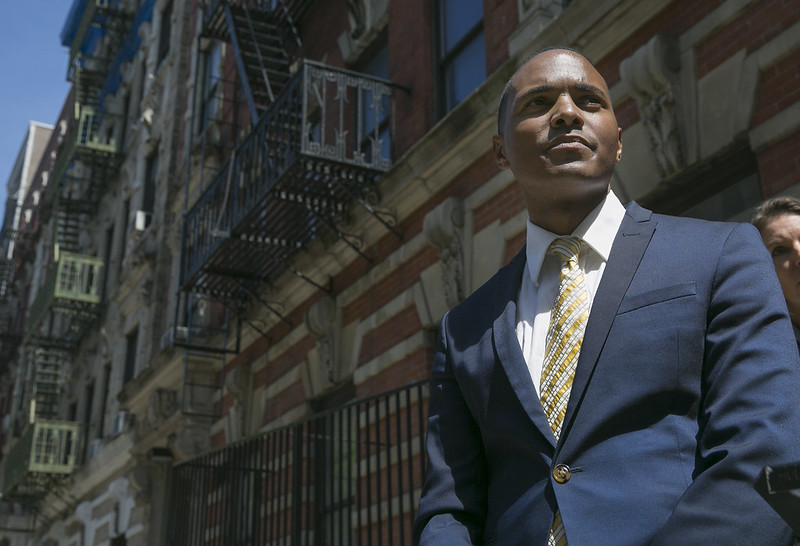
Ritchie Torres (photo: William Alatriste/City Council)
As this month’s primary election results seem to be proving, the winds of change are blowing and are shifting the direction of Latino politics in New York City. Has a new era of leadership in Latino political representation arrived?
In the Bronx, Ritchie Torres seems to be ahead with a comfortable margin, defeating Michael Blake, long-time politico Ruben Diaz, Sr., and many others in the 15th Congressional District. In these pages I predicted that Torres was one to take very seriously. The future has arrived. When all ballots are counted, I expect Torres to pull off the victory.
Torres now joins Alexandria Ocasio-Cortez (AOC), Nydia Velazquez, and Adriano Espaillat as the Latino congressional representatives in New York City. Torres and AOC, though, represent a new and perhaps more progressive voice, one that is representative of the younger Latino generation. Surveys indicate that members of this younger generation tend to be more progressive than their parents and grandparents. Three years ago (when AOC was still bartending) I wrote: “Torres is charismatic, well-liked by his peers, and whip-smart. He has the uncanny ability to probe and articulate complex policy matters. At 29 years of age, Torres will surely be one to watch for years to come.”
Now with a bigger platform, I anticipate that Torres will be a formidable force on behalf of the Latino community for years to come.
Perhaps the strongest wind of change in Latino politics is blowing from Queens. Jessica González-Rojas appears to be defeating incumbent Assemblymember Michael DenDekker. González-Rojas, who was endorsed by Tiffany Cabán but interestingly enough not AOC, is now the fourth Latina to be elected in Queens, following the elections of AOC, Jessica Ramos, and Catalina Cruz two years ago.
Two things are important about these successes: First, that we are seeing the rise of female representation among Latino political representatives. Latinas have rightly felt emboldened by the lack of progress that was evident in our communities and have responded by elbowing their way to the table, knowing that they have something to offer and contribute to Latino communities. And the communities are responding by electing them.
Currently, there are 31 Latino elected officials in the city, including the addition of González-Rojas. Women now represent 42% of all Latino elected officials in the city—from Congress to the City Council. (Here, I am not including the numerous women that hold party positions.) While there is much more to do to make that figure more representative of the Latina presence within the electorate and society at large, the trend is encouraging.
With the re-election of the women mentioned above, and the election of González-Rojas, the 2020 primary election cycle may come to be known as the year of the Latina. It’s about time! I am certain that the late Olga Mendez, the first Latina in the country to be elected to the state Legislature (representing East Harlem for many years) is smiling from above.
Additionally, the addition of González-Rojas to Queens’ representation also marks a shift in the center of Latino voter participation and presence. Whereas formerly the Bronx was almost exclusively where Latino elected officials resided, we are now seeing the results of what has been a steady increase in the Latino population in Queens. As we’ve seen with AOC, Ramos, Cruz, and now González-Rojas, more Latino candidates are being elected in the borough of Queens. The Archie Bunker days seem to be over. A new era is being ushered in.
In the future, I will take a deeper dive into the significance of the Latino vote in this primary cycle. For now, as results continue to trickle in and as we await the Board of Elections’ counting of absentee ballots and certification of outcomes, the Latino community should be proud of its seeming awakening.
***
Eli Valentin is a political analyst and author of the forthcoming book, Reinhold Niebuhr: A Political Life. On Twitter @EliValentinNY.
***
Have an op-ed idea or submission for Gotham Gazette? Email This email address is being protected from spambots. You need JavaScript enabled to view it.




